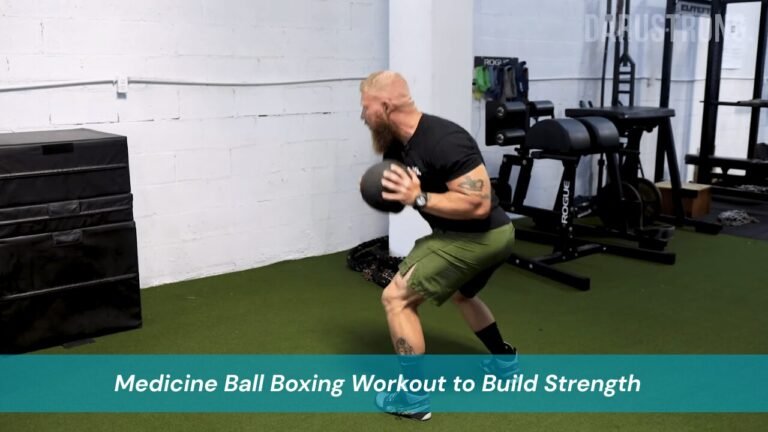Boxing has always been considered one of the most demanding sports in the world, not only because of the physical intensity but also because of the mental sharpness it requires. Beyond the boxing ring, the training itself has gained massive popularity among fitness enthusiasts, athletes, and even beginners who want to get in shape. A boxing gym workout is a powerful way to improve cardiovascular health, build lean muscle, and develop mental discipline while learning a skill that enhances coordination and self-confidence.
If you have ever watched professional fighters train, you know their routines are anything but easy. However, the beauty of boxing training is that it can be adapted for all fitness levels. You don’t need to be an aspiring fighter to reap the rewards. With consistency, the right guidance, and progressive training, you can experience the same benefits of strength, stamina, and focus that boxers develop in the gym. This article will take you through everything you need to know about boxing gym workouts, from their benefits and structure to sample training routines and advanced strategies for maximum results.
Why a Boxing Gym Workout Stands Out
Unlike many traditional workout styles that isolate specific muscle groups, boxing engages the entire body. Every punch you throw activates muscles in your arms, shoulders, back, core, and legs. The constant movement required during footwork and defensive maneuvers keeps your heart rate elevated, making it a high-intensity cardiovascular workout. In one session, you not only strengthen your muscles but also build explosive power and endurance.
Another unique aspect of boxing is its mental component. Unlike repetitive gym routines that may feel monotonous, boxing challenges your brain as much as your body. You must think about combinations, maintain your stance, react to imaginary or real opponents, and stay mentally sharp even when you are fatigued. This constant focus improves coordination, reflexes, and concentration, which are useful skills both inside and outside the gym.
Moreover, boxing is one of the most effective workouts for fat loss. A vigorous training session can burn anywhere from 500 to 800 calories depending on intensity. Unlike long, steady-state cardio sessions, boxing alternates bursts of high energy with short recovery periods, mimicking high-intensity interval training (HIIT). This not only helps burn calories during the workout but also boosts metabolism afterward, allowing you to continue burning fat long after you’ve left the gym.
The Essential Components of a Boxing Gym Workout
Every effective boxing workout inside the gym is built around a structured flow that prepares the body, develops technical skill, and strengthens physical endurance. While routines may vary depending on the coach or the athlete’s goals, there are several core components that form the backbone of boxing training.
Warm-Up and Mobility Work
Boxing is highly dynamic, and starting with cold muscles can increase the risk of injury. That is why a boxing gym workout always begins with a warm-up phase designed to raise body temperature, activate muscles, and improve mobility. Jumping rope is a classic warm-up choice in boxing gyms. It improves cardiovascular endurance while also enhancing coordination and footwork. Shadowboxing at the start of the session is equally important, as it helps loosen up the body while mentally preparing you to execute techniques with precision. Dynamic movements such as arm circles, hip rotations, and lunges also play a role in opening up joints and improving range of motion before the real intensity begins.
Technique Training and Skill Development
Boxing is not only about throwing powerful punches but also about refining technique. After warming up, many boxers move into shadowboxing drills, often performed in front of a mirror. This allows them to practice proper stance, hand positioning, head movement, and combinations without the pressure of a physical target. From there, footwork drills may be incorporated to ensure agility and balance. Correct footwork allows you to move fluidly around the ring, conserve energy, and stay defensively sound.
Another important aspect of skill training involves repeating the four fundamental punches: the jab, cross, hook, and uppercut. Each punch uses different muscle groups and mechanics, and practicing them in isolation before combining them ensures that technique becomes second nature. Over time, you can progress from basic movements to more advanced combinations that challenge both speed and accuracy.
Heavy Bag and Pad Work
The heavy bag is one of the most recognizable tools in any boxing gym. Striking the bag develops punching power, endurance, and rhythm. Boxers often perform timed rounds on the bag that mimic the structure of an actual fight, such as three minutes of intense punching followed by a one-minute rest. Different rounds may emphasize different goals: one round may focus on speed, another on powerful strikes, and another on combination building.
Pad work, usually done with a coach or partner, adds a dynamic element to training. The trainer calls out combinations and moves around, forcing the boxer to think, react, and maintain defensive responsibility while attacking. This type of work improves accuracy, timing, and the ability to anticipate movement. Unlike the heavy bag, pads provide immediate feedback, which helps refine technique and strategy.
Conditioning and Core Strength
A boxing gym workout is incomplete without conditioning. Since boxing is an endurance sport that demands explosive energy, conditioning exercises push the body beyond comfort zones. Exercises such as push-ups, burpees, squat jumps, and medicine ball slams build explosive power while simulating the short bursts of energy needed in a fight. Core training is also essential, as every punch originates from the hips and torso. Strong abs and obliques improve punching power, balance, and resistance against body shots. Planks, Russian twists, and hanging leg raises are staples in most boxing gyms to ensure the core is as strong as the arms and legs.
A Sample Boxing Gym Workout Routine
To give you a clearer picture, here is an example of a structured boxing gym workout designed for beginners but adaptable for more advanced athletes.
The session starts with a warm-up that lasts about five minutes. During this phase, you can jump rope for a couple of minutes, then transition into dynamic stretches and light shadowboxing. This helps activate muscles while preparing your cardiovascular system for the intensity to come.
Once warmed up, move into shadowboxing drills. Spend three rounds of two minutes each practicing simple combinations, focusing on your jab and cross at first before incorporating hooks and footwork. Remember, this stage is not about power but about precision, timing, and fluid movement.
The main portion of the workout typically involves heavy bag training. Four rounds of three minutes each is a standard approach. During the first round, you might focus exclusively on straight punches such as the jab and cross. The second round can introduce combinations that mix hooks and uppercuts. In the third round, emphasize defense, slipping and weaving before countering with combinations. The fourth round can be dedicated to maximum effort, throwing punches at full speed and power to push your endurance.
If a partner or coach is available, pad work can be included. This adds variety and helps simulate fight-like conditions. Three rounds of reacting to called-out combinations while moving with your trainer improves reaction time, accuracy, and fight awareness.
The conditioning segment follows. Spend around fifteen minutes rotating through exercises like push-ups, burpees, Russian twists, and planks. These will strengthen your core, improve stamina, and develop the explosive energy needed for boxing.
Finally, the session ends with a cool-down. Stretching your shoulders, legs, and back ensures proper recovery while reducing the risk of soreness and injury. Deep breathing exercises at this stage also help calm the body after high-intensity training.
Tips for Success in Boxing Gym Workouts
To get the most out of your boxing workouts, consistency and attention to detail are key. Beginners should never rush into throwing hard punches without mastering proper form. Poor technique not only limits progress but also increases the risk of injury. Investing in high-quality gloves and hand wraps is essential to protect your wrists and knuckles during training.
It is equally important to pace yourself. Boxing is intense, and overtraining in the beginning can quickly lead to burnout. Start with two to three sessions per week and gradually build up frequency as your fitness and recovery improve. Variety is another crucial factor. Repeating the same routine every time can limit progress, so alternate between heavy bag sessions, mitt work, sparring practice, and conditioning drills to keep both the body and mind challenged.
Hydration and nutrition also play major roles in performance. Because boxing workouts are highly demanding, fueling the body with lean proteins, complex carbohydrates, and healthy fats ensures steady energy levels. Staying hydrated before, during, and after training is equally critical, especially since sweating is extensive during high-intensity sessions.
Advanced Strategies for Experienced Boxers
For those who already have a foundation in boxing training, incorporating advanced strategies can elevate performance. Interval-based bag drills, where you alternate between light combinations and explosive power punches, mimic the unpredictability of a real fight. Adding resistance training, such as weighted shadowboxing or resistance bands during footwork, further develops strength and endurance.
Sparring is another key element for advanced athletes. While optional for fitness enthusiasts, sparring provides invaluable experience in timing, defense, and ring control. It is essential, however, that sparring is done under proper supervision with protective equipment and respect for safety.
Some athletes also integrate cross-training to complement their boxing. Activities like swimming, sprinting, and plyometric training enhance cardiovascular endurance, agility, and explosive movement, all of which translate directly into better boxing performance.
FAQs
How many times a week should I do a boxing gym workout?
Beginners should aim for two to three sessions per week to allow their bodies time to adapt and recover. Intermediate and advanced athletes can train four to five times per week depending on their goals and recovery ability.
Can boxing replace traditional cardio workouts?
Yes, boxing can replace traditional cardio. It keeps your heart rate elevated like running or cycling but also engages multiple muscle groups at once, providing both cardiovascular and strength benefits.
Do I need prior experience to start a boxing gym workout?
No prior experience is required. Most gyms offer beginner-friendly classes that cover the basics of stance, movement, and punches. Over time, you can progress to more advanced techniques and routines.
Is boxing good for weight loss?
Absolutely. A single boxing gym workout can burn 500–800 calories, depending on intensity. Combined with proper nutrition, it is an effective way to lose fat while building lean muscle.
What equipment do I need for a boxing gym workout?
Basic equipment includes quality boxing gloves, hand wraps, and comfortable training shoes. Some gyms provide gloves and bags, but having your own ensures proper fit and hygiene.
Conclusion
A boxing gym workout is much more than just hitting a bag. It is a complete system that builds strength, endurance, and mental resilience. It conditions the body through demanding cardio and strength exercises, while also sharpening the mind through technique and coordination. Whether your goal is to lose weight, improve fitness, or step into the ring one day, boxing offers one of the most effective and rewarding training methods available.
By approaching training with patience, consistency, and proper technique, anyone can experience the transformative effects of boxing. From beginners stepping into the gym for the first time to seasoned athletes seeking an edge, boxing remains one of the ultimate workouts for both the body and the mind.




